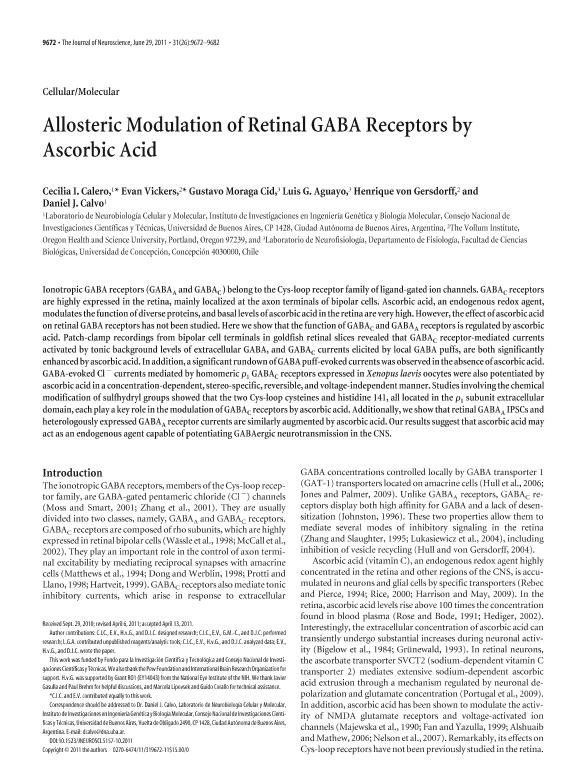Mostrar el registro sencillo del ítem
dc.contributor.author
Calero, Cecilia Ines

dc.contributor.author
Vickers, Evan
dc.contributor.author
Cid, Gustavo Moraga
dc.contributor.author
Aguayo, Luis G.
dc.contributor.author
von Gersdorff, Henrique
dc.contributor.author
Calvo, Daniel Juan

dc.date.available
2019-07-12T18:16:33Z
dc.date.issued
2011-04
dc.identifier.citation
Calero, Cecilia Ines; Vickers, Evan; Cid, Gustavo Moraga; Aguayo, Luis G.; von Gersdorff, Henrique; et al.; Allosteric modulation of retinal GABA receptors by ascorbic acid; Society for Neuroscience; Journal of Neuroscience; 31; 26; 4-2011; 9672-9682
dc.identifier.issn
0270-6474
dc.identifier.uri
http://hdl.handle.net/11336/79501
dc.description.abstract
Ionotropic GABA receptors (GABAA and GABAC) belong to the Cys-loop receptor family of ligand-gated ion channels. GABAC receptors are highly expressed in the retina, mainly localized at the axon terminals of bipolar cells. Ascorbic acid, an endogenous redox agent, modulates the function of diverse proteins, and basal levels of ascorbic acid in the retina are very high. However, the effect of ascorbic acid on retinal GABA receptors has not been studied. Here we show that the function of GABAC and GABAA receptors is regulated by ascorbic acid. Patch-clamp recordings from bipolar cell terminals in goldfish retinal slices revealed that GABAC receptor-mediated currents activated by tonic background levels of extracellular GABA, and GABAC currents elicited by local GABA puffs, are both significantly enhanced by ascorbic acid. In addition, a significant rundown of GABA puff-evoked currents was observed in the absence of ascorbic acid. GABA-evoked Cl- currents mediated by homomeric ρ1 GABAC receptors expressed in Xenopus laevis oocytes were also potentiated by ascorbic acid in a concentration-dependent, stereo-specific, reversible, and voltage-independent manner. Studies involving the chemical modification of sulfhydryl groups showed that the two Cys-loop cysteines and histidine 141, all located in the ρ1 subunit extracellular domain, each play a key role in the modulation of GABAC receptors by ascorbic acid. Additionally, we show that retinal GABAA IPSCs and heterologously expressed GABAA receptor currents are similarly augmented by ascorbic acid. Our results suggest that ascorbic acid may act as an endogenous agent capable of potentiating GABAergic neurotransmission in the CNS.
dc.format
application/pdf
dc.language.iso
eng
dc.publisher
Society for Neuroscience

dc.rights
info:eu-repo/semantics/openAccess
dc.rights.uri
https://creativecommons.org/licenses/by-nc-sa/2.5/ar/
dc.subject
Gaba Receptors
dc.subject
Redox Modulation
dc.subject
Ascorbic Acid
dc.subject
Retina
dc.subject.classification
Neurociencias

dc.subject.classification
Medicina Básica

dc.subject.classification
CIENCIAS MÉDICAS Y DE LA SALUD

dc.title
Allosteric modulation of retinal GABA receptors by ascorbic acid
dc.type
info:eu-repo/semantics/article
dc.type
info:ar-repo/semantics/artículo
dc.type
info:eu-repo/semantics/publishedVersion
dc.date.updated
2019-07-11T18:31:44Z
dc.journal.volume
31
dc.journal.number
26
dc.journal.pagination
9672-9682
dc.journal.pais
Estados Unidos

dc.journal.ciudad
Washington
dc.description.fil
Fil: Calero, Cecilia Ines. Consejo Nacional de Investigaciones Científicas y Técnicas. Instituto de Investigaciones en Ingeniería Genética y Biología Molecular "Dr. Héctor N. Torres"; Argentina
dc.description.fil
Fil: Vickers, Evan. Oregon Health and Science University; Estados Unidos
dc.description.fil
Fil: Cid, Gustavo Moraga. Universidad de Concepción; Chile
dc.description.fil
Fil: Aguayo, Luis G.. Universidad de Concepción; Chile
dc.description.fil
Fil: von Gersdorff, Henrique. Oregon Health and Science University; Estados Unidos
dc.description.fil
Fil: Calvo, Daniel Juan. Consejo Nacional de Investigaciones Científicas y Técnicas. Instituto de Investigaciones en Ingeniería Genética y Biología Molecular "Dr. Héctor N. Torres"; Argentina
dc.journal.title
Journal of Neuroscience

dc.relation.alternativeid
info:eu-repo/semantics/altIdentifier/url/https://www.ncbi.nlm.nih.gov/pmc/articles/PMC3160198/
dc.relation.alternativeid
info:eu-repo/semantics/altIdentifier/doi/http://dx.doi.org/10.1523/JNEUROSCI.5157-10.2011
dc.relation.alternativeid
info:eu-repo/semantics/altIdentifier/url/https://www.jneurosci.org/content/31/26/9672
Archivos asociados
